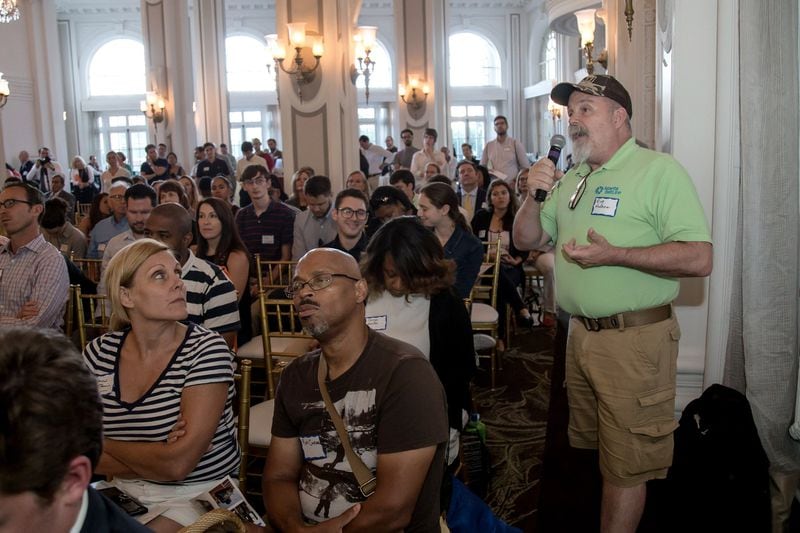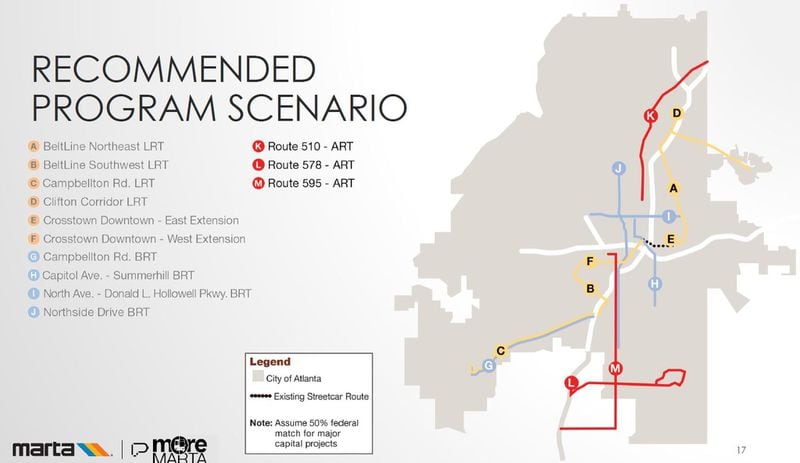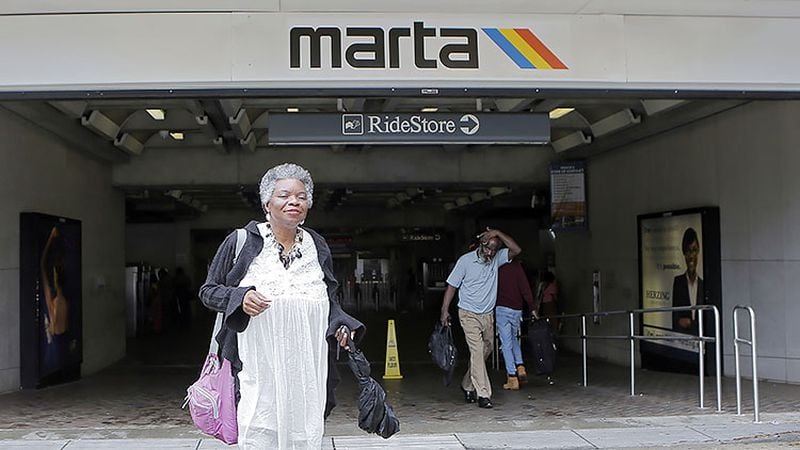MARTA is close to finalizing an Atlanta transit expansion plan that will influence where people, jobs and prosperity flow in the economic capital of the South for generations.
But with city residents demanding far more rail and bus improvements than the agency has money to pay for, the final plan is bound to leave many people unhappy.
MARTA has $2.5 billion to spend over the next 40 years, thanks to a transit sales tax approved by Atlanta voters in 2016. But it’s working from a list that includes $11.5 billion in potential projects, and many won’t make the final cut when the board approves a final list in September.
Among those lobbying for their favorite projects are supporters of light rail along the Atlanta Beltline, the Clifton Corridor and Campbellton Road. In recent public meetings, Beltline supporters have made the most noise. They fear the sales tax money MARTA is preparing to spend is their best – and maybe last – chance for funding for decades.
“We’re pulling out all the stops,” said Beltline supporter Rick Hudson of the Grant Park Neighborhood Association. “We’ve had 600 people in the room at a City Council meeting and a thousand people at City Hall to let our voices be heard. We’re not newbies to this.”
But the new sales tax money may also be the last best chance for other big-ticket projects. If Beltline supporters get the 22 miles of light rail they want, other projects may have to be scaled back or put on hold.
MARTA officials have spent weeks soliciting public input on the proposed list. They've assured residents that no final decisions have been made, and that public opinion matters.
But they acknowledge there simply isn’t enough money to pay for every project.
“We are working very hard to get this right,” said MARTA Board Chairman Robbie Ashe. “But we realize that, at the end of the day, somebody’s likely to be disappointed.”
The Atlanta expansion is a milestone for an agency that hasn’t built a new rail line since the completion of the Red Line to North Springs in 2000.
City voters overwhelmingly approved a half-penny sales tax for MARTA two years ago. And in May the agency unveiled its proposed plan to spend the proceeds.
The plan includes 21 miles of light rail; 18 miles of bus rapid transit lines; other new bus routes; two new transit centers, and renovation of existing stations.
Among the major projects proposed:
- The four-mile Clifton Corridor light rail line from MARTA's Lindbergh station to the Emory University/Centers for Disease Control and Prevention area recently annexed by Atlanta.
- A third of the 22-mile Atlanta Beltline light rail loop through dozens of Atlanta neighborhoods.
- Transit improvements along Campbellton Road in southwest Atlanta. MARTA would start with enhanced bus service, then upgrade to bus rapid transit in dedicated lanes before finally building light rail along the line. The plan would create a continuous light rail line stretching from Emory to southwest Atlanta.
Among the projects that didn't make the proposed list: a heavy rail extension on I-20 west and a bus rapid transit line along I-20 east.
MARTA officials said they used a variety of criteria to compile the list. Their goals included connecting people to jobs, reducing travel time in various corridors and dispersing transit improvements across the city, so that as many people as possible benefit.
But no matter how they slice the data, they say there isn’t enough money for everyone’s favorite project – even with federal matching funds.
“Two and a half billion dollars is a lot of money,” Ashe said. “But we have more needs than that.”
That’s touched off some intense lobbying, with supporters touting the benefits of their favorite projects and questioning the merits of others.
The Clifton Corridor has been the top punching bag. Critics say the Emory area wasn’t even in Atlanta when city voters approved the transit sales tax. But they say it’s jumped to the front of the line for transit funding – at $503.6 million, it’s the single-largest project on MARTA’s proposed list.
“I hate to see them prioritizing Emory, which – up until after we voted – wasn’t even part of Atlanta,” Hudson said.
The project was on the potential project list approved by the City Council in 2016. And supporters say there’s a reason the Clifton Corridor is a priority: It’s the region’s largest employment center without direct access to MARTA rail or an interstate highway.
Betty Willis, a senior associate vice president at Emory University, said the Clifton Corridor also could be the city’s best shot for federal funding – crucial to any rail project.
“I don’t think you want to go to [Washington] D.C. asking for federal funds for projects that are not realistic,” Willis said. “That will be rejected.”
‘City with huge aspirations’
Campbellton Road supporters note the existing bus route serving the corridor is one of the busiest in the MARTA system – a sign that a light rail line might be well-used. And they say southwest Atlanta has long waited while other parts of Atlanta got infrastructure improvements.
“We’ve been putting up with everything out here, and it’s time we got ours,” said Charnette Trimble, who lives in the Oakland City neighborhood. “And we’re going to get ours.”
Some Beltline supporters have suggested using money from both the Clifton Corridor and the Campbellton light rail lines to complete the proposed light rail loop around the city.
The Beltline is a proposed loop of trails, parks and other amenities connecting Atlanta neighborhoods. Supporters say transit is essential to fulfilling a vision for urban living that has gained national attention.
“Atlanta has always been a city with huge aspirations. But often they haven’t carried them out fully,” Grant Park’s Hudson said. “I’d like to see them take this through from beginning to end. That’s what the city needs.”
But even some Beltline supporters doubt the full loop will make the final project list.
“That’s just not realistic,” said Brian McGowan, the outgoing CEO of Atlanta Beltline Inc., the organization overseeing its development. “There’s Campbellton Road. There’s Clifton Corridor. There’s $11.5 billion [in projects] on that list for $2.5 billion [in funding].”
McGowan said he supports transit along the entire Beltline route and is still hopeful it can get more funding.
For projects that don’t make the cut, there are other possible sources of revenue, including state funding, local taxing districts and public-private partnerships.
Compared to $2.5 billion from a sales tax that’s already been approved, those revenue sources are uncertain. But MARTA has pledged to keep searching for money.
“However we end up allocating these dollars, we will continue to pursue additional transit funding,” Ashe said, “both for the projects we identify and for those that don’t make the final list.”










